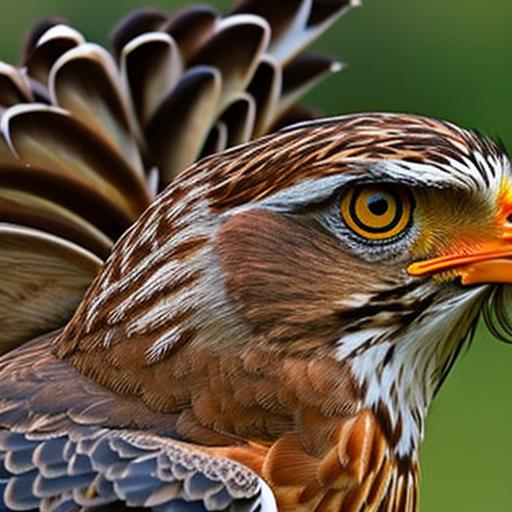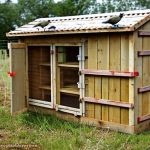Keeping chickens can be a rewarding and fulfilling experience, but it also comes with its fair share of challenges. One of the biggest threats to your flock is the presence of hawks. These birds of prey are skilled hunters and can pose a significant danger to your chickens. Understanding the threat that hawks pose and taking proactive measures to protect your flock is essential for their safety and well-being.
Hawks are known for their sharp talons and keen eyesight, which make them formidable predators. They have a strong instinct to hunt and will target small animals, including chickens, as potential prey. Hawks are opportunistic hunters and will take advantage of any opportunity to catch an easy meal. This means that even if you have a small flock, they are still at risk of being targeted by hawks.
Key Takeaways
- Hawks pose a serious threat to chickens and their safety should not be taken lightly.
- Different types of hawks have different hunting habits and understanding them can help in protecting your chickens.
- Creating a secure chicken coop with protective measures like chicken wire is crucial in keeping hawks away.
- Visual deterrents like scarecrows and reflective tape, as well as sound-based tactics like predator calls, can also be effective in deterring hawks.
- Training your chickens to be alert and providing adequate shelter and cover, as well as implementing a rotation system, can further protect them from hawk attacks.
Identifying the Different Types of Hawks and Their Hunting Habits
There are several different types of hawks that pose a threat to your chickens. The most common ones include the Red-tailed Hawk, Cooper’s Hawk, and Sharp-shinned Hawk. Each of these hawks has its own hunting habits and preferences when it comes to targeting their prey.
The Red-tailed Hawk is one of the largest hawks in North America and is known for its broad wingspan and distinctive red tail feathers. They typically hunt from perches or while soaring in the sky, scanning the ground for potential prey. Red-tailed Hawks primarily target small mammals but will also go after chickens if given the opportunity.
Cooper’s Hawks and Sharp-shinned Hawks are smaller in size but are equally skilled hunters. They have long tails and short wings, which allow them to maneuver through dense vegetation with ease. These hawks are known for their agility and speed, making them particularly dangerous to chickens. They often hunt by surprise, swooping down on their prey from above.
Creating a Safe and Secure Chicken Coop: Tips and Tricks
One of the most effective ways to protect your chickens from hawks is to create a safe and secure chicken coop. A well-designed coop will not only keep your chickens safe from predators but also provide them with a comfortable and stress-free environment.
When building or modifying your chicken coop, it’s important to consider the following factors:
1. Size: Ensure that your coop is spacious enough to accommodate your flock comfortably. Overcrowding can lead to stress and increase the risk of injury or disease.
2. Ventilation: Proper ventilation is crucial for maintaining good air quality inside the coop. Install windows or vents to allow fresh air to circulate while keeping predators out.
3. Flooring: Use materials that are easy to clean and disinfect, such as concrete or vinyl flooring. This will help prevent the buildup of bacteria and parasites.
4. Nesting Boxes: Provide enough nesting boxes for your hens to lay their eggs comfortably. Make sure they are elevated off the ground and have a secure entrance to prevent predators from accessing them.
5. Roosting Bars: Install sturdy roosting bars at different heights to accommodate all your chickens. This will give them a safe place to sleep at night, away from potential predators.
Installing Chicken Wire and Other Protective Measures Around Your Coop
| Protective Measures | Materials Needed | Cost | Time Required |
|---|---|---|---|
| Installing chicken wire around coop | Chicken wire, wire cutters, staples, staple gun | 50-100 | 2-4 hours |
| Adding hardware cloth to windows and vents | Hardware cloth, wire cutters, staples, staple gun | 20-50 | 1-2 hours |
| Securing doors with locks or latches | Locks, latches, screws, screwdriver | 10-20 | 30 minutes-1 hour |
| Installing predator-proof flooring | Hardware cloth, wire cutters, staples, staple gun, plywood | 50-100 | 2-4 hours |
In addition to creating a secure coop, it’s important to install chicken wire and other protective measures around your coop to keep hawks out. Chicken wire is an effective barrier that can prevent hawks from accessing your chickens.
When installing chicken wire, make sure it is securely attached to the coop and extends at least six feet high around the perimeter. Bury the bottom edge of the wire at least six inches deep into the ground to prevent predators from digging underneath.
You can also consider adding additional protective measures such as predator-proof fencing or netting over the top of the coop. This will provide an extra layer of security and prevent hawks from swooping down from above.
Using Visual Deterrents to Scare Away Hawks
Visual deterrents can be an effective way to scare away hawks and prevent them from targeting your chickens. These deterrents work by creating a visual distraction or threat that hawks find intimidating or alarming.
One popular visual deterrent is the use of scarecrows or fake predators. Placing a scarecrow or a fake owl near your coop can create the illusion of a larger predator in the area, deterring hawks from approaching. You can also try hanging shiny objects such as CDs or aluminum foil strips around your coop. The reflective surfaces will catch the sunlight and create flashes of light that can startle hawks.
Another visual deterrent is the use of predator eyes or decals. These are stickers or decals that resemble the eyes of a larger predator, such as a wolf or a coyote. Hawks are instinctively wary of larger predators and will avoid areas where they believe they are being watched.
Employing Sound-Based Tactics to Keep Hawks at Bay

Sound-based tactics can also be effective in keeping hawks away from your chickens. Hawks rely heavily on their acute hearing to locate prey, so loud and sudden noises can startle them and deter them from approaching.
One sound-based tactic is the use of wind chimes or bells around your coop. The sound of the chimes or bells will create a constant noise that can make hawks uncomfortable and discourage them from coming near.
You can also try using a motion-activated sprinkler system. These systems are equipped with sensors that detect movement and release a burst of water when triggered. The sudden spray of water can startle hawks and make them think twice about approaching your coop.
Training Your Chickens to Stay Safe and Alert
Training your chickens to stay safe and alert can go a long way in protecting them from hawks. Chickens are naturally curious animals, but they can also be easily startled. By teaching them to be aware of their surroundings and to seek shelter when they sense danger, you can help them avoid becoming easy targets for hawks.
One way to train your chickens is to introduce them to different sounds and stimuli from a young age. This can include playing recordings of hawk calls or other predator sounds. By exposing them to these sounds in a controlled environment, you can help them recognize the danger and learn to take cover.
You can also train your chickens to respond to a specific command or signal that indicates danger. For example, you can use a whistle or a bell to signal them to return to the safety of the coop. With consistent training and reinforcement, your chickens will learn to associate the sound with the need for caution.
Providing Adequate Shelter and Cover for Your Chickens
Providing adequate shelter and cover for your chickens is essential for their safety and protection from hawks. Chickens are naturally inclined to seek shelter when they sense danger, so it’s important to provide them with suitable hiding spots within their coop or run.
Ensure that your coop has enough hiding places such as bushes, shrubs, or dense vegetation where your chickens can take cover if they feel threatened. These hiding spots should be strategically placed around the coop and run, providing multiple escape routes for your chickens.
You can also consider adding natural deterrents such as thorny bushes or prickly plants around the perimeter of your coop. These plants will create an additional barrier that hawks will find difficult to navigate.
Implementing a Rotation System to Limit Exposure to Predators
Implementing a rotation system can help limit your chickens’ exposure to predators, including hawks. By regularly moving your chickens to different areas of your property, you can reduce the risk of hawks becoming familiar with their presence and targeting them as easy prey.
Create multiple designated areas or pens within your property where you can rotate your chickens. This will allow the ground to recover from their scratching and pecking while also reducing the risk of attracting predators.
When implementing a rotation system, it’s important to ensure that each area has the necessary protection and security measures in place. This includes installing chicken wire, providing adequate shelter, and using visual and sound-based deterrents.
Taking a Proactive Approach to Protecting Your Chickens from Hawks
Protecting your chickens from hawks requires a proactive approach and a combination of different strategies. By understanding the threat that hawks pose and implementing the tips and tricks discussed in this article, you can significantly reduce the risk of your flock falling victim to these predators.
Remember to create a safe and secure chicken coop, install chicken wire and other protective measures, use visual and sound-based deterrents, train your chickens to stay safe and alert, provide adequate shelter and cover, and implement a rotation system to limit exposure to predators.
By taking these proactive measures, you can ensure the safety and well-being of your chickens while enjoying the many benefits of keeping a backyard flock.
If you’re looking for the best way to keep hawks away from your chickens, you might find this article on Poultry Wizard helpful. It provides valuable tips and strategies to protect your flock from these predatory birds. From building a secure chicken coop to using scare tactics, the article covers various methods that can effectively deter hawks and ensure the safety of your chickens. Check it out here.
FAQs
What are hawks?
Hawks are birds of prey that belong to the family Accipitridae. They are known for their sharp talons, hooked beaks, and keen eyesight.
Why do hawks attack chickens?
Hawks attack chickens because they are a source of food. Chickens are easy prey for hawks because they are slow-moving and cannot fly very high.
What are the signs of a hawk attack?
Signs of a hawk attack on chickens include missing birds, feathers scattered around the coop or yard, and claw marks on the ground.
What is the best way to keep hawks away from chickens?
The best way to keep hawks away from chickens is to provide them with a covered area to hide in, such as a coop or covered run. You can also use scare tactics, such as hanging shiny objects or using a fake owl or hawk decoy.
Are there any natural predators of hawks?
Yes, hawks have natural predators such as eagles, owls, and larger hawks. However, these predators are not typically found in areas where chickens are kept.
Can hawks be trained to stay away from chickens?
No, hawks cannot be trained to stay away from chickens. They are wild animals and will continue to hunt for food wherever they can find it.
Meet Walter, the feathered-friend fanatic of Florida! Nestled in the sunshine state, Walter struts through life with his feathered companions, clucking his way to happiness. With a coop that’s fancier than a five-star hotel, he’s the Don Juan of the chicken world. When he’s not teaching his hens to do the cha-cha, you’ll find him in a heated debate with his prized rooster, Sir Clucks-a-Lot. Walter’s poultry passion is no yolk; he’s the sunny-side-up guy you never knew you needed in your flock of friends!







